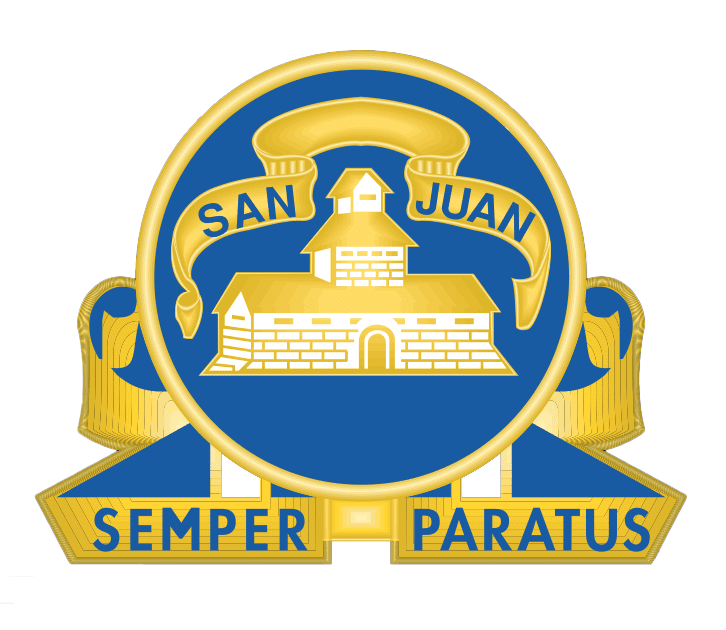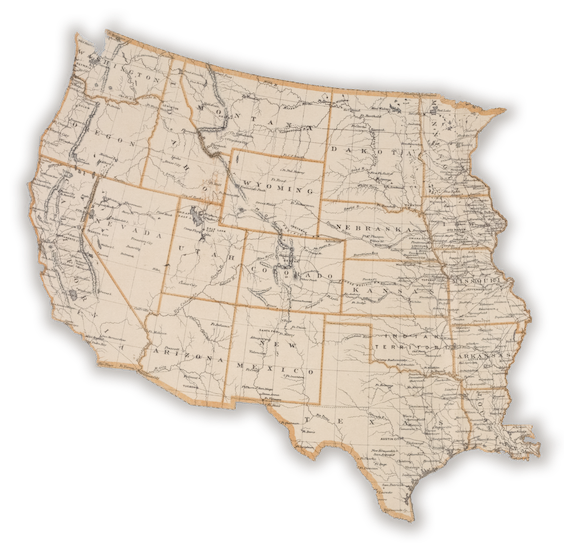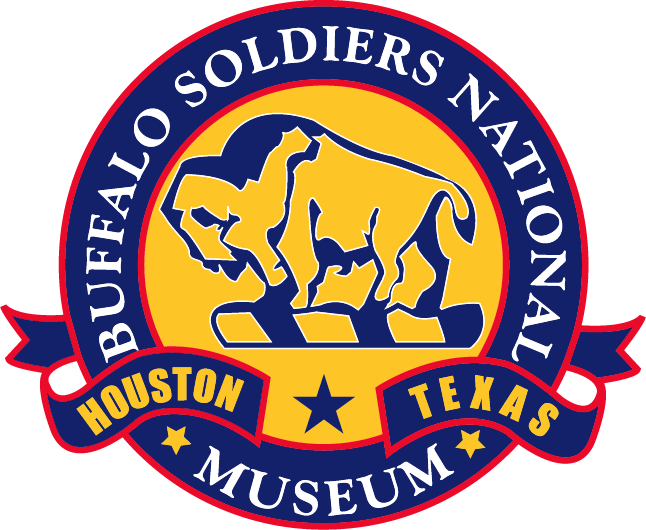Who are the Buffalo Soldiers?
9th
Cavalry
10th
Cavalry

24th
Infantry Regiment

25th
Infantry Regiment
In 1866, through an act of Congress, legislation was adopted to create six all African American Army units. The units were identified as the 9th and 10th cavalry and the 38th, 39th, 40th, and 41st infantry regiments. In 1869, the four infantry regiments were reorganized to form the 24th and 25th infantry regiments.
How did the Buffalo Soldiers get their name?

Westward Expansion
African Americans have fought in military conflicts since colonial days. However, the Buffalo Soldiers, comprised of former slaves, freemen and Black Civil War soldiers, were the first to serve during peacetime.
Once the Westward movement had begun, prominent among those blazing treacherous trails of the Wild West were the Buffalo Soldiers of the U.S. Army. These African Americans were charged with and responsible for escorting settlers, cattle herds, and railroad crews. The 9th and 10th Cavalry Regiments also conducted campaigns against American Indian tribes on a western frontier that extended from Montana in the Northwest to Texas, New Mexico, and Arizona in the Southwest.
The Buffalo Soldiers have played a major role in nearly all major American wars
After Abraham Lincoln issued the Emancipation Proclamation in January 1863, the US Government officially began recruiting, enlisting, and training black soldiers. However, the army only allowed African Americans to serve as enlisted men in segregated infantry, cavalry, and artillery regiments under the command of white officers and initially paid black soldiers less than white soldiers. By the end of the war in 1865, nearly 180,000 African Americans had served in the army with another 19,000 black sailors serving in the Navy. Approximately 40,000 of these servicemen died over the course of the Civil War.
When the Spanish-American War began, the 24th and 25th Infantry along with the 9th and 10th Cavalry were some of the most experienced units in the U.S. Army and were thus among the first units to deploy to Cuba in the summer of 1898. The U.S. government also authorized the formation of four additional volunteer regiments of black infantrymen with a handful of black junior officers. Black soldiers were at the vanguard of several battles including El Caney and the more famous Battle of San Juan Hill with Theodore Roosevelt and the Rough Riders. African American soldiers received national praise for their service from the American press, white officers, and even U.S. president William McKinley.
Black regiments who had served in Cuba during the Spanish-American War also served in the Philippines between 1899 and 1902 when the U.S. occupied the Philippines as part of the peace negotiations with Spain.
During the Mexican Expedition, the 10th Cavalry joined General John J. Pershing’s forces in pursuit of Fracisco “Pancho” Villa in retaliation for attacks against the United States during the Mexican Revolution. The 10th Cavalry met with the insurgent forces during the Battle of Carrizal in June 1916, after which the Mexican and United States governments opened negotiations for the withdrawal of the US forces from Mexico.
When the United States entered World War I in 1917, the War Department, under President Woodrow Wilson’s administration rejected the enlistment of blacks in the military. However, manpower shortages quickly forced the War Department to revise this policy. By the end of the war, nearly 368,000 black Americans would serve in the American military. During the war, the army commissioned African-American officers at an unprecedented level and opened many branches of service where black troops had previously been excluded from. In an effort to separate black troops from white troops, American commanders placed the 93rd Infantry Division under the command of the French Army. Famed units like the Harlem Hellfighters (369th Infantry Regiment) distinguished themselves in combat with hundreds of black troops earning French military decorations for valor in battle.
By the end of World War II, over 900,000 black men and women had served in the American military. Nearly 7,000 other African Americans served as commissioned officers. Many of these were finally able to serve in new roles like fighter pilots (Tuskegee Airmen), as paratroopers (555th Parachute Infantry Regiment), in the Women’s Army Corps (WAC), in armored combat units (761st Tank Battalion), and in the Marine Corps. The 761st Tank Battalion was one of the first units in World War II to breach the Siegfried Line which ultimately opened a path for the Allied Army into Germany. The Tuskegee Airmen escorted performed 179 bomber escort missions losing bombers on only seven of the missions.
Although President Harry S. Truman had ordered the end of racial segregation in the military, the actual implementation of this process in the post-World War II military was slow. However, at the outbreak of hostilities in Korea, the 24th Infantry, 77th Engineer, and the 159th Field Artillery regiments (all black units) were among the first units deployed from Japan to Korea and achieved the first military victories in the war by recapturing the town of Yechon. At the same time, the U.S. army continued to advance its program of racial integration: basic training units on the home front were integrated and the army eventually integrated the segregated forces fighting in Korea in 1951. For the first time, black officers and black non-commissioned officers served as leaders in integrated units with direct command over whites.
The Formation of the First African American Service Units.
9th Cavalry
Constituted on July 28, 1866, in the Regular Army as the 9th Cavalry and organized September 21, 1866, in Greenville, LA, the Buffalo Soldiers of the 9th Cavalry served selflessly and dedicatedly through the settling of the Great American Frontier. The unit saw constant field duty from 1867 to 1890, protecting travelers and forts throughout south and west Texas. Soldiers of the unit earned 15 Medals of Honor during their service on the frontier: 11 by enlisted men and 4 by officers. During the Spanish-American War, the unit captured a Spanish blockhouse defending the city of Santiago; consequently, a blockhouse appears on the regimental crest. The unit continued to serve through the Philippine Insurrection and was eventually inactivated during World War II in North Africa.
10th Cavalry
Constituted on July 28, 1866, in the Regular Army as the 10th Cavalry and organized September 21, 1866, at Fort Leavenworth, KS, the 10th Cavalry Buffalo Soldiers served for over 2 decades of continuous deployment on the Great Plains and in Arizona and New Mexico. The regiment distinguished itself during the Spanish-American War at Santiago and Las Guardians, and in the famous charge up San Juan Hill alongside Theodore Roosevelt’s Rough Riders. The 10th Cavalry fought for 48 hours under heavy fire until the hill was successfully taken. After serving in the Philippine Insurrection and the Mexican Expedition, the unit continued to serve in the western United States until it was eventually inactivated during World War II.


24th & 25th Infantry Regiments
The 24th Infantry Regiment was organized in 1869 after consolidation of two other Black units, 38th and 41st Infantry Regiments. For more than twenty years, the unit occupied military post in the southwest, protecting and maintaining peace on the turbulent frontier. In addition to battle engagements, the members of the regiment built roads, guarded stage stations, constructed and repaired telegraph lines, guarded waterholes, and escorted supply trains, survey parties, freight wagons and mail coaches, as well as performing scouting patrols.
The 25th Infantry Regiment was organized at Jackson Barracks, Louisiana in April 1868, and composed of personnel from the all Black 39th and 40th Infantry Regiments. The enlisted men came mostly from northern Virginia and southern Louisiana, and all were seasoned Union veterans. The regiment only spent a short time at Jackson Barracks before moving to the Texas frontier.
In May and June 1870, the entire regiment went in bivouac for the last time as a unit for many years to come after which they were scattered to numerous posts in West Texas. They established and operated a lumber camp and sawmill, managed food and supply routes, built roads, buildings, telegraph lines, and carried out scouting functions while engaging in conflicts with various warring factions.
The Uniform of
a Buffalo Soldier
Buffalo Soldiers often received secondhand uniforms, the poorest quality horses and the worst equipment. Hover over the icons on the uniform to read more about the articles of clothing and equipment that they wore.

Campaign Hat
A buffalo Soldier was outfitted with a slouch “campaign” hat, black at first and a light grayish-brown by 1874.
Neckerchief
The Buffalo Soldiers were not issued a neckerchief but generally wore one of his own color of choice anyway. Sometimes yellow more often red or white. These were real necessities, especially for the men riding further back in the column needing protection from the thick clouds of dust kicked up by the front ranks.
Uniform
During the 1870-1880’s, the Buffalo Soldier wore a flannel shirt, and a blouse of dark blue.
Weaponry
A Buffalo Soldier was armed with a 45-70 Springfield carbine (rifle), a Colt Army .45, (1873 model) caliber pistol and a saber.
Trousers & Boots
During the 1870-1880’s, the Buffalo Soldier wore light blue trousers tucked into over-the-knee boots.




